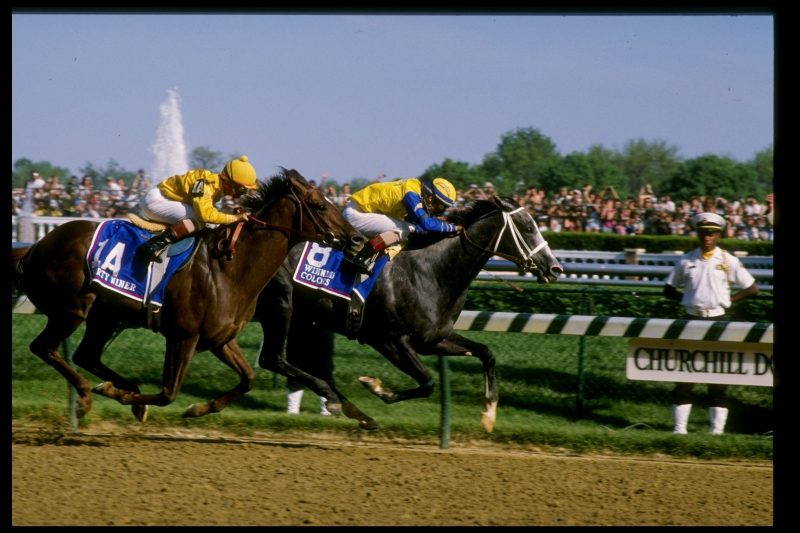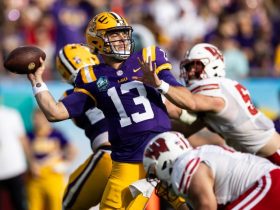LOUISVILLE, Ky. – On three remarkable, memorable and eternally celebrated occasions in the 150-year history of the Kentucky Derby, America’s most famous horse race produced America’s Sweetheart.
Regret in 1915.
Genuine Risk in 1980.
Winning Colors in 1988.
They are names that will live forever in Derby lore, a trio of fillies who conquered what is arguably the most demanding task in the sport: Beating the boys on the first Saturday in May.
Sadly, they may be the last of their kind.
“I think it’s a shame,” said veteran trainer Kenny McPeek. “What did Bonnie Raitt say? Let’s give them something to talk about, right?”
At a time when more people than ever are paying attention to women in sports, Thoroughbred racing – in an equine sense, at least – has been way ahead of the pack.
The question of whether a top filly can compete against colts has been part of the sport’s mystique as long as horse racing has been around. Plenty of owners and trainers throughout history have been bold enough to try, with fillies like Zenyatta, Rachel Alexandra and Beholder elevating their status as all-time greats with memorable performances against male horses.
But the Kentucky Derby has always been the rarest of rare challenges for fillies. Some of that is owed to relatable human factors like size and physiological differences that would suggest fillies might be more competitive in their own company. Some of it, historically, has been fear of a filly not being able to withstand the 1 1/4-mile distance so early in their 3-year-old season (this is also a question about most colts, to be fair). And for the owner or trainer of an elite filly, there’s a simple financial calculation about whether it would be better to try for the Derby or run in an “easier” race like the Kentucky Oaks the day before that offers a healthy $1.5 million purse.
“We ran a couple (fillies in the Derby) that we should have run in the Oaks,” said legendary trainer D. Wayne Lukas. “We won the Oaks five times and we’d probably have won it seven or eight times.”
Nobody has tried more fillies in the Derby than Lukas: Four altogether, including Winning Colors, who delivered Lukas his first victory in 1988. But now, even Lukas would have a tough time repeating that feat simply because of what it takes to get a filly to the starting gate.
How Derby points system affects fillies
Prior to 2012, the qualification formula to enter the Kentucky Derby was based on graded-stakes earnings in all races regardless of what kind of races they were. Since then, Churchill Downs has installed a points system based on a series of designated Derby prep races, all of which are geared toward the colts.
In general, this development has been a net positive for the race, eliminating sprinters or horses who might have won a big 2-year-old race but didn’t develop further at age 3. The downside, though, is that any owner or trainer who might want to put a filly in the mix has to make that decision relatively early and start to earn enough points in those specific prep races for colts to get in the top 20 of the standings.
The net effect is undeniable: Nobody has entered a filly in the Derby since 2010, and it’s unclear when – or if – that might change.
“The points system makes it a little tough,” said Brad Cox, who has had one of the nation’s strongest contingent of fillies in his barn over the last handful of years. “There is opportunity if you want to run against the boys prior to the Derby, but often we just find ourselves taking the path of trying to win the Oaks. Honestly, I haven’t had a filly to date that I felt like I wanted to try against the boys to accumulate points toward the Derby.”
Most Thoroughbred trainers are, like Cox, relatively conservative when it comes to handling their top-end fillies. But it’s not sexism, it’s economics: Just like for colts, the big money isn’t only on the racetrack but in the breeding shed. When the top fillies are either eventually sold as broodmares or have foals who go to auction, there aren’t any bonus points for winning the Derby or even beating colts.
Neither Genuine Risk nor Winning Colors passed on their talent to the next generation. Zenyatta, who became the only filly or mare to win the Breeders’ Cup Classic in 2009, was bred to some of America’s leading stallions but produced nothing that made an impact on the racetrack. Breeding champions is part art, part science and a whole lot of mystery.
So the primary factor for running a filly in the Derby would be the pure sporting challenge of such a feat, and some are more up for it than others.
‘Throw gender aside’
In 1980, trainer LeRoy Jolley had famously taken a stand against running Genuine Risk in the Derby after a third-place finish against colts in the Wood Memorial. Keep in mind, this was only five years after the brilliant filly Ruffian tragically broke down in a match race against Kentucky Derby winner Foolish Pleasure and had to be euthanized. At that time in American racing, there was still perhaps some psychological trauma about running fillies against colts.
But Genuine Risk’s owners, Bert and Diana Firestone, wanted the opportunity for their filly. They entered her in the Derby and accomplished something nobody had seen in more than six decades.
Four years later, Lukas showed up at Churchill with both Life’s Magic, the champion 2-year-old filly, and Althea, who had registered a stunning win in the Arkansas Derby. They finished eighth and 19th, respectively.
But Lukas wasn’t deterred. In the spring of 1988, he felt Winning Colors was the fastest 3-year-old in America – filly or colt – and entered her in the Santa Anita Derby. She dominated the race by seven lengths and went wire-to-wire at Churchill a few weeks later, holding off Forty Niner by a neck for the first of Lukas’ four Derby wins.
“You have to just throw gender aside,” Lukas said. “Is she equal to the colts? Does she have that kind of ability that she can compete with the colts? And you need to test the water I think a little bit. I don’t think many of the younger trainers are willing to go out that far on the limb and take a chance.”
Since Winning Colors, two fillies have won the Preakness and one captured the Belmont, so it stands to reason one could win the Derby again if given the opportunity. McPeek trained one of those fillies when Swiss Skydiver beat Derby winner Authentic in the 2020 Preakness that was moved to October due to the COVID-19 pandemic. He said if his filly Thorpedo Anna wins the Kentucky Oaks on Friday, the Preakness would be an option for her next race.
He’d like to see the points system adjusted so that there could be some potential crossover between Derby and Oaks qualification, giving owners and trainers of top fillies an option to at least consider running against the boys. He thinks it would create conversation and intrigue and, ultimately, be good for the sport.
“There aren’t many that will be brave enough to do it,” McPeek said. ‘But you’ll never have another Genuine Risk or Winning Colors if you don’t.”






